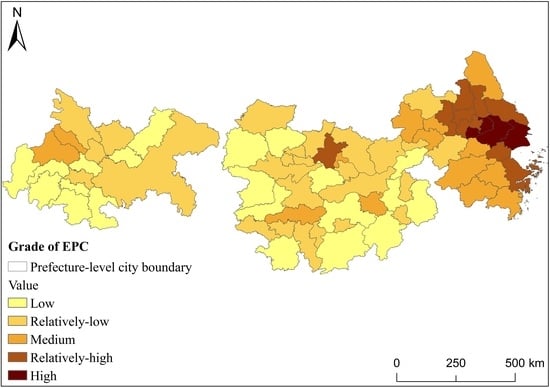Research on the Spatio-Temporal Dynamic Evolution Characteristics and Influencing Factors of Electrical Power Consumption in Three Urban Agglomerations of Yangtze River Economic Belt, China Based on DMSP/OLS Night Light Data
Abstract
1. Introduction
2. Research Area and Data Sources
2.1. Research Area
2.2. Data Sources
3. Research Methods
3.1. Coefficient of Variation
3.2. Kernel Density Estimation
3.3. Hot Spot Analysis
3.4. Trend Analysis
3.5. Standard Deviation Ellipse
3.6. Moran’s I Index
3.7. Geographically Weighted Regression (GWR) Model
3.8. Random Forest Algorithm
4. Results
4.1. Temporal and Spatial Evolution Characteristics of EPC of YREB Three Urban Agglomerations at Different Scales
4.2. The Spatial Structure Evolution Characteristics of the EPC of the Three Major Urban Agglomerations of the YREB
4.3. The Evolution Characteristics of the Spatial Pattern of EPC in the Three Major Urban Agglomerations of the YREB
4.4. Change Trend Analysis of EPC of YREB’s Three Major Urban Agglomerations
4.5. The Evolution Characteristics of the Spatial Pattern of the EPC of the Three Major Urban Agglomerations of YREB
4.6. Spatial Autocorrelation Analysis of EPC of YREB’s Three Major Urban Agglomerations
4.7. Spatial-Temporal Difference Analysis of Influencing Factors of EPC in Three Urban Agglomerations in the Yreb Based on GWR
4.8. Analysis of the Importance of Factors Affecting EPC in the Three Major Urban Agglomerations in the YREB Based on Random Forest Algorithm
5. Discussions and Conclusions
5.1. Discussions
5.2. Conclusions
Author Contributions
Funding
Institutional Review Board Statement
Informed Consent Statement
Data Availability Statement
Conflicts of Interest
References
- Cao, X.F.; Yang, G.Y.; Song, M.L. Research on Influencing Factors of Power Energy Efficiency in China. Sci. Decis. 2011, 17, 76–93. (In Chinese) [Google Scholar]
- Wu, J.; Tang, L. Research on the Influencing Factors of Provincial Power Intensity in china—Based on the Analysis of Spatial Metrology Model. Price Theory Pract. 2020, 40, 53–56. (In Chinese) [Google Scholar]
- Xie, Y.H.; Weng, Q.H. Detecting urban-scale dynamics of electricity consumption at Chinese cities using time-series DMSP-OLS (Defense Meteorological Satellite Program-Operational Linescan System) nighttime light imageries. Energy 2016, 100, 177–189. [Google Scholar] [CrossRef]
- Cao, X.; Wang, J.M.; Chen, J.; Shi, F. Spatialization of electricity consumption of China using saturation-corrected DMSP-OLS data. Int. J. Appl. Earth Obs. Geoinf. 2014, 28, 193–200. [Google Scholar] [CrossRef]
- Chand, T.R.K.; Badarinath, K.V.S.; Elvidge, C.D.; Tuttle, B.T. Spatial characterization of electrical power consumption patterns over India using temporal DMSP-OLS night-time satellite data. Int. J. Remote Sens. 2009, 30, 647–661. [Google Scholar] [CrossRef]
- Jia, R.X.; Liu, Y. Research on optimization of China's power resource structure and spatial layout. Resour. Sci. 2003, 25, 14–19. (In Chinese) [Google Scholar]
- Zhao, N.Z.; Ghosh, T.; Samson, E.L. Mapping spatiotemporal changes of Chinese electric power consumption using night-time imagery. Int. J. Remote Sens. 2012, 20, 20–6320. [Google Scholar]
- Bao, C.; Liu, R.W. Electricity Consumption Changes across China’s Provinces Using A Spatial Shift-Share Decomposition Model. Sustainability 2019, 11, 1–15. [Google Scholar]
- He, C.Y.; Ma, Q.; Li, T.; Yang, Y.; Liu, Z.F. Spatiotemporal dynamics of electric power consumption in Chinese Mainland from 1995 to 2008 modeled using DMSP/OLS stable nighttime lights data. J. Geogr. Sci. 2012, 22, 125–136. [Google Scholar] [CrossRef]
- He, C.Y.; Ma, Q.; Liu, Z.F.; Zhang, Q.F. Modeling the spatiotemporal dynamics of electric power consumption in Mainland China using saturation corrected DMSP/OLS nighttime stable light data. Int. J. Digit. Earth 2014, 7, 993–1014. [Google Scholar] [CrossRef]
- Deng, C.B.; Lin, W.Y.; Chen, S.L. Use of smart meter readings and nighttime light images to track pixel-level electricity consumption. Remote Sens. Lett. 2019, 10, 205–213. [Google Scholar] [CrossRef]
- Yang, X.C.; Kang, L.L.; Zhang, B.; Ji, C.X. Electricity consumption estimation and influencing factors analysis based on multi-source remote sensing information—Taking Zhejiang Province as an example. Geogr. Sci. 2013, 33, 718–723. (In Chinese) [Google Scholar]
- Pan, J.H.; Li, J.F. Spatiotemporal Dynamics of Electricity Consumption in China. Appl. Spat. Anal. Policy 2019, 12, 395–422. [Google Scholar] [CrossRef]
- Elvidge, C.D.; Cinzano, P.; Pet, D.R. The nights at mission concept. Int. J. Remote Sens. 2007, 8, 2645–2670. [Google Scholar] [CrossRef]
- Huang, X.M.; Schneider, A.; Friedl, M.A. Mapping sub-pixel urban expansion in China using MODIS and DMSP/OLS nighttime lights. Remote Sens. Environ. 2016, 175, 92–108. [Google Scholar] [CrossRef]
- Ma, T.; Zhou, Y.K.; Zhou, C.H.; Pei, T.; Xu, T. Night-time light derived estimation of spatio-temporal characteristics of urbanization dynamics using DMSP/OLS satellite data. Remote Sens. Environ. 2015, 158, 453–464. [Google Scholar] [CrossRef]
- Zhang, X.X.; Guo, S.; Guan, Y.N.; Cai, D.L.; Zhang, C.Y.; Fraedrich, K.; Xiao, H.; Tian, Z.Z. Urbanization and Spillover Effect for Three Megaregions in China: Evidence from DMSP/OLS Nighttime Lights. Remote Sens. 2018, 10, 1–16. [Google Scholar] [CrossRef]
- Chen, X.; Peng, J.; Liu, Y.X.; Chen, Y.Q.; Li, T.D. Measurement of urban spatial expansion and spatial correlation in Beijing-Tianjin-Hebei region based on DMSP/OLS night light data. Geogr. Res. 2018, 37, 898–909. [Google Scholar]
- Li, C.; Li, G.E.; Zhu, Y.J.; Ge, Y.; Kung, H.T.; Wu, Y.J. A likelihood-based spatial statistical transformation model (LBSSTM) of regional economic development using DMSP/OLS time-series nighttime light imagery. Spatial Statistics. Spat. Stat. 2017, 21, 421–439. [Google Scholar] [CrossRef]
- Fu, H.Y.; Shao, Z.F.; Fu, P.; Cheng, Q.M. The Dynamic Analysis between Urban Nighttime Economy and Urbanization Using the DMSP/OLS Nighttime Light Data in China from 1992 to 2012. Remote Sens. 2017, 9, 1–19. [Google Scholar] [CrossRef]
- Qi, K.; Hu, Y.N.; Cheng, C.Q.; Chen, B. Transferability of Economy Estimation Based on DMSP/OLS Night-Time Light. Remote Sens. 2017, 9, 1–13. [Google Scholar] [CrossRef]
- Wang, J.H.; Zhang, Y.B.; Yi, G.H.; Bie, X.J.; Liu, D.; Zhang, T.T. Spatial analysis of Sichuan GDP based on DMSP/OLS night light data. Surv. Mapp. Sci. 2019, 44, 50–60. (In Chinese) [Google Scholar]
- Lv, Q.; Liu, H.B.; Wang. J., T.; Liu., H.; Shang, Y. Multiscale analysis on spatiotemporal dynamics of energy consumption CO2 emissions in China: Utilizing the integrated of DMSP-OLS and NPPVIIRS nighttime light datasets. Sci. Total Environ. 2020, 703, 1–12. (In Chinese) [Google Scholar] [CrossRef]
- Yue, Y.L.; Tian, L.; Yue, Q.; Wang, Z. Spatiotemporal Variations in Energy Consumption and Their Influencing Factors in China Based on the Integration of the DMSP-OLS and NPP-VIIRS Nighttime Light Datasets. Remote Sens. 2020, 12, 1–23. [Google Scholar] [CrossRef]
- Zhang, X.W.; Wu, J.S.; Peng, J.; Cao, Q.W. The Uncertainty of Nighttime Light Data in Estimating Carbon Dioxide Emissions in China: A Comparison between DMSP-OLS and NPP-VIIRS. Remotesensing 2017, 12, 1–20. [Google Scholar] [CrossRef]
- Zhang, Y.N.; Pan, J.H. Spatiotemporal simulation and differentiation pattern of China's carbon emissions based on DMSP/OLS data. China Environ. Sci. 2019, 39, 1436–1446. [Google Scholar]
- Huang, Q.X.; Yang, Y.; Li, Y.J.; Gao, B. A Simulation Study on the Urban Population of China Based on Nighttime Light Data Acquired from DMSP/OLS. Sustainability 2016, 8, 1–13. [Google Scholar] [CrossRef]
- Sun, W.C.; Zhang, X.; Wang, N.; Cen, Y. Estimating Population Density Using DMSP-OLS Night-Time Imagery and Land Cover Data. IEEE J. Sel. Top. Appl. Earth Obs. Remote Sens. 2017, 10, 2674–2684. [Google Scholar] [CrossRef]
- Yu, S.S.; Zhang, Z.X.; Liu, F. Monitoring Population Evolution in China Using Time-Series DMSP/OLS Nightlight Imagery. Remote Sens. 2018, 10, 1–21. [Google Scholar] [CrossRef]
- Chen, Q.; Hou, X.Y. Integrate land use data and night light data to optimize population spatialization model. J. Geo-Inf. Sci. 2015, 17, 1370–1377. (In Chinese) [Google Scholar]
- Ma, Z.Y.; Xiao, H.W. Study on my country's Provincial Power Consumption Simulation Based on Satellite Light Data. 2017, 39, 6–14. (In Chinese) [Google Scholar]
- Hu, T.; Huang, X. A novel locally adaptive method for modeling the spatiotemporal dynamics of global electric power consumption based on DMSP-OLS nighttime stable light data. Appl. Energy 2019, 240, 778–792. [Google Scholar] [CrossRef]
- Zhu, Y.G.; Xu, D.Y.; Ali, S.H.; Ma, R.Y.; Cheng, J.H. Can Nighttime Light Data Be Used to Estimate Electric Power Consumption? New Evidence from Causal-Effect Inference. Energies 2019, 12, 1–14. [Google Scholar] [CrossRef]
- Husi, L.; Masanao, H.; Hiroshi, Y.; Kazuhiro, N.; Gegen, T.; Fumihiko, N.; Okada, S. Estimating energy consumption from night-time DMPS/OLS imagery after correcting for saturation effects. Int. J. Remote Sens. 2010, 16, 4443–4458. [Google Scholar]
- Shi, K.F.; Yu, B.L.; Huang, C.; Wu, J.P.; Sun, X. Exploring spatiotemporal patterns of electric power consumption in countries along the Belt and Road. Energy 2018, 150, 847–859. (In Chinese) [Google Scholar] [CrossRef]
- Cowan, W.N.; Chang, T.Y.; Roula, I.L.; Rangan, G. The nexus of electricity consumption, economic growth and CO2 emissions in the BRICS countries. Energy Policy. 2014, 66, 359–368. [Google Scholar] [CrossRef]
- Zhu, J.; Zhao, Z.Y. Chinese Electric Power Development Coordination Analysis on Resource, Production and Consumption:A Provincial Case Study. Sustainability 2017, 9, 1019. [Google Scholar] [CrossRef]
- Li, S.Y.; Cheng, L.; Liu, X.P.; Mao, J.Y.; Wu, J.; Li, M.C. City type-oriented modeling electric power consumption in China using NPP-VIIRS nighttime stable light data. Energy 2019, 189, 1–12. [Google Scholar] [CrossRef]
- Shi, K.F.; Yu, B.L.; Huang, Y.X.; Hu, Y.J.; Yin, B.; Chen, Z.Q.; Chen, L.J.; Wu, J.P. Evaluating the Ability of NPP-VIIRS Nighttime Light Data to Estimate the Gross Domestic Product and the Electric Power Consumption of China at Multiple Scales: A Comparison with DMSP-OLS Data. Remote Sens. 2014, 6, 1–20. [Google Scholar] [CrossRef]
- Lin, J.; Shi, W.Z. Statistical Correlation between Monthly Electric Power Consumption and VIIRS Nighttime Light. Isprs Int. J. Geo-Inf. 2020, 9, 1–13. [Google Scholar] [CrossRef]
- Pan, J.H.; Li, J.F. China’s electricity consumption estimation and temporal dynamics based on night light images. Geogr. Res. 2016, 35, 627–638. [Google Scholar]
- Sumana, S.; Prasun, K.G.; Srivastav, S.K. Comparative analysis between VIIRS-DNB and DMSP-OLS night-time light data to estimate electric power consumption in Uttar Pradesh, India. Int. J. Remote Sens. 2020, 41, 2565–2580. [Google Scholar]
- Arati, P.; Bhuvanesh, V.; Debasish, C. Estimating electrification using multi-temporal DMSP/OLS night imagery as proxy measure of human well-being in India. Spat. Inf. Res. 2020, 28, 469–473. [Google Scholar]
- Bismay, R.T.; Haroon, S.; Elvidge, C.D.; Yu, T.; Prem, C.P.; Meenu, R.I.; Pavan, K. Modeling of Electric Demand for Sustainable Energy and Management in India Using Spatio-Temporal DMSP-OLS NightTime Data. Environ. Manag. 2018, 61, 615–623. [Google Scholar]
- Tomasz, J. Modeling electricity consumption using nighttime light images and artificial neural networks. Energy 2019, 179, 831–842. [Google Scholar]
- Alexander, C.; Bruce, T.D.A. The use of nighttime lights satellite imagery as a measure of Australia's regional electricity consumption and population distribution. Int. J. Remote Sens. 2019, 31, 4459–4480. [Google Scholar]
- Lin, J.T.; Shi, W.Z. Improved Denoising of VIIRS Nighttime Light Imagery for Estimating Electric Power Consumption. Ieee Geosci. Remote Sens. Lett. 2020, 17, 1782–1786. [Google Scholar] [CrossRef]
- Li, X.; Xue, X.Y. Estimation method of luminous remote sensing power consumption based on Boston matrix. J. Wuhan Univ. 2018, 43, 1994–2002. (In Chinese) [Google Scholar]
- Shi, K.F.; Yang, Q.Y.; Fang, G.L.; Yu, B.L.; Chen, Z.Q.; Yang, C.S.; Wu, J.P. Evaluating spatiotemporal patterns of urban electricity consumption within different spatial boundaries: A case study of Chongqing, China. Energy 2019, 167, 641–653. [Google Scholar] [CrossRef]
- Li, F.; Sun, G.T.; Wang, Q.L.; Qian, A. Research on Spatialization of County-level Electricity Consumption Based on NPP-VIIRS Night Light Data. Surv. Spat. Geogr. Inf. 2018, 41, 8–18. (In Chinese) [Google Scholar]
- Fan, X.J.; Zhang, Y.F.; Cheng, Z.Z. Research on Xinjiang’s Energy Consumption from 1992 to 2013 Based on DMSP/OLS Night Light Data. Remote Sens. Land Resour. 2019, 31, 212–2019. (In Chinese) [Google Scholar]
- Liu, Z.M.; Cui, Z.W.; Zhu, P.H.; Chen, C.C. The dynamic temporal and spatial characteristics of electricity consumption in China and its driving factors. China's Popul. Resour. Environ. 2019, 29, 20–29. (In Chinese) [Google Scholar] [CrossRef]
- Liu, W. Analysis of Regional Economic Disparities in the Yangtze River Economic Zone. Resour. Environ. Yangtze River Basin 2006, 15, 131–135. (In Chinese) [Google Scholar]
- Chen, B.W.; Wu, C.Y.; Huang, X.J.; Yang, X.F. Examining the Relationship between Urban Land Expansion and Economic Linkage Using Coupling Analysis: A Case Study of the Yangtze River Economic Belt, China. Sustainability 2020, 12, 1227. [Google Scholar] [CrossRef]
- Wang, H.; Yang, G.Q.; Qin, J.Y. City Centrality, Migrants and Green Inovation Efficiency: Evidence from 106 Cities in the Yangtze River Economic Belt of China. Int. J. Environ. Res. Public Health 2020, 17, 652. [Google Scholar] [CrossRef] [PubMed]
- Wu, P.P.; Zhu, X.C.; Wang, W. Research on the Impact of Inter-city Industrial Links on Economic Output in the Ten Major Urban Agglomerations in the Yangtze River Economic Belt—Based on the Inter-industry Gravity Model Method. Urban Dev. Res. 2017, 24, 49–55. (In Chinese) [Google Scholar]
- Tan, F.F.; Bi, J. An inquiry into water transfer network of the Yangtze River Economic Belt in China. J. Clean. Prod. 2018, 176, 288–297. [Google Scholar] [CrossRef]
- Wang, C.W.; Meng, Q.C. Research on the Sustainable Synergetic Development of Chinese Urban Economies in the Context of a Study of Industrial Agglomeration. Sustainability 2020, 12, 1122. [Google Scholar] [CrossRef]
- Wu, C.Y.; Huang, X.J.; Chen, B.W.; Li, J.B.; Xu, J. The Spatial Pattern of Economic Connections in the Yangtze River Economic Belt and the Trend of Economic Integration. Econ. Geogr. 2017, 37, 71–78. (In Chinese) [Google Scholar]
- Zhuo, L.; Guan, X.F.; Ye, S.S. Prediction Analysis of the Coordinated Development of the Sports and Pension Industries: Taking 11 Provinces and Cities in the Yangtze River Economic Belt of China as an Example. Sustainability 2020, 12, 2493. [Google Scholar] [CrossRef]
- Wang, W.X.; Xu, J.X.; Wang, X.X.; Ji, L.J.; Qi, C.J. Time and space differentiation of the coupling relationship between modern agriculture, regional economy and ecological environment in the Yangtze River Economic Zone. Agric. Mod. Res. 2020, 41, 64–74. (In Chinese) [Google Scholar]
- Wang, D.G.; Sun, F. Coordination degree of land transportation accessibility and urbanization space in the Yangtze River Economic Zone. Geogr. Sci. 2018, 38, 1089–1097. (In Chinese) [Google Scholar]
- Zhu, W.W.; Wang, M.C.; Zhang, B.B. The effects of urbanization on PM2. 5 concentrations in China's Yangtze River Economic Belt: New evidence from spatial econometric analysis. J. Clean. Prod. 2019, 239, 118065. [Google Scholar] [CrossRef]
- Xu, X.B.; Hu, H.Z.; Tan, Y.; Yang, G.S.; Zhu, P.; Jiang, B. Quantifying the impacts of climate variability and human interventions on crop production and food security in the Yangtze River Basin, China, 1990–2015. Sci. Total Environ. 2019, 665, 379–389. [Google Scholar] [CrossRef] [PubMed]
- Zhang, R.T.; Lu, J.F. Analysis of Multi-scale Temporal and Spatial Characteristics and Influencing Factors of Cultivated Land Intensive Use in the Yangtze River Economic Zone. J. Agric. Eng. 2019, 35, 271–278. (In Chinese) [Google Scholar]
- Guan, D.J.; He, X.J.; He, C.Y.; Cheng, L.D.; Qu, S.J. Does the urban sprawl matter in Yangtze River Economic Belt, China? An integrated analysis with urban sprawl index and one scenario analysis model. Cities 2020, 99, 102611. [Google Scholar] [CrossRef]
- Zhong, Y.; Lin, A.W.; He, L.J.; Zhou, Z.G.; Yuan, M.X. Spatiotemporal Dynamics and Driving Forces of Urban Land-Use Expansion: A Case Study of the Yangtze River Economic Belt, China. Remotesensing 2020, 12, 287. [Google Scholar] [CrossRef]
- Wu, C.Y.; Huang, X.J.; Chen, B.W. Telecoupling mechanism of urban land expansion based on transportation accessibility: A case study of transitional Yangtze River economic Belt, China. Land Use Policy 2020, 96, 104687. [Google Scholar] [CrossRef]
- Ma, Y. Measurement of the Coupling Coordination Effect of Urbanization and Eco-environment in the Yangtze River Economic Zone and Verification of the Interactional Stress Relationship. Resour. Environ. Yangtze River Basin 2020, 29, 275–286. (In Chinese) [Google Scholar]
- Huang, Y.; Li, L.; Yu, Y.T. Do urban agglomerations outperform non-agglomerations? A new perspective on exploring the eco-efficiency of Yangtze River Economic Belt in China. J. Clean. Prod. 2018, 202, 1056–1067. [Google Scholar] [CrossRef]
- Luo, Q.L.; Zhou, Q.F.; Song, Y. Does China's Yangtze River Economic Belt policy impact on local ecosystem services? Sci. Total Environ. 2019, 676, 231–241. [Google Scholar] [CrossRef]
- Xu, X.B.; Jiang, B.; Chen, M.K.; Bai, Y.; Yang, G.S. Strengthening the effectiveness of nature reserves in representing ecosystem services: The Yangtze River Economic Belt in China. Land Use Policy 2020, 96, 104717. [Google Scholar] [CrossRef]
- Chang, J.W. How to coordinate the relationship between ecological environment protection and economic development in the Yangtze River Economic Zone. Resour. Environ. Yangtze River Basin 2018, 27, 1409–1412. (In Chinese) [Google Scholar]
- Chen, J.X.; Zhang, Y.G.; Zheng, S.L. Ecoefficiency, environmental regulation opportunity costs, and interregional industrial transfers: Evidence from the Yangtze River Economic Belt in China. J. Clean. Prod. 2019, 233, 611–625. [Google Scholar] [CrossRef]
- Li, L.; Liu, Y. Industrial Green Spatial Pattern Evolution of Yangtze River Economic Belt in China. Chin. Geogr. Sci. 2017, 27, 660–672. [Google Scholar] [CrossRef]
- Liu, Y.L.; Zhang, X.H.; Pan, X.Y.; Ma, X.X.; Tang, M.Y. The spatial integration and coordinated industrial development of urban agglomerations in the Yangtze River Economic Belt, China. Cities 2020, 104, 102801. [Google Scholar] [CrossRef]
- Tang, C.L.; Chen, W.Y.; Wu, J.M.; Zhou, G.H.; Wang, M.X.; Guo, X.S. Research on the Spatial Distribution and Industrial Agglomeration Characteristics of Development Zones in the Yangtze River Economic Zone. Geogr. Sci. 2020, 40, 657–664. [Google Scholar]
- Tian, Y.; Sun, C.W. Comprehensive carrying capacity, economic growth and the sustainable development of urban areas: A case study of the Yangtze River Economic Belt. J. Clean. Prod. 2018, 195, 486–496. [Google Scholar] [CrossRef]
- Xie, H.L.; Zhu, Z.H.; Wang, B.H.; Liu, G.Y.; Zhai, Q.L. Does the Expansion of Urban Construction Land Promote Regional Economic Growth in China? Evidence from 108 Cities in the Yangtze River Economic Belt. Sustainability 2018, 10, 4073. [Google Scholar] [CrossRef]
- Zhang, Z.D.; Wang, T.T. The impact of industrial clusters, urban agglomerations and their interactions on regional economic growth: Taking the urban agglomerations in the Yangtze River Economic Belt as an example. Urban Probl. 2019, 39, 55–62. (In Chinese) [Google Scholar]
- Zhang, J.R.; Shi, G.Q. The impact of public infrastructure capital stock on regional economic growth—Taking the Yangtze River Economic Belt as an example. Resour. Environ. Yangtze River Basin 2019, 28, 1552–1562. (In Chinese) [Google Scholar]
- Wu, J.S.; Wu, Y.; Peng, J.; Wang, Z.; Huang, X.L. Energy consumption dynamics of prefecture-level cities in China from 1995 to 2009 based on DMSP/OLS night lighting data. Geogr. Res. 2014, 33, 625–634. (In Chinese) [Google Scholar]
- Lin, Z.L.; Xu, H.Q.; Huang, S.L. Dynamic monitoring of urban expansion in coastal areas of eastern China based on DMSP/OLS night light images. J. Earth Inf. Sci. 2019, 21, 1074–1085. (In Chinese) [Google Scholar]
- Shi, K.F.; Chen, Y.; Yu, B.L.; Xu, T.B.; Yang, C.S.; Li, L.Y.; Huang, C.; Chen, Z.Q.; Liu, R.; Wu, J. Detecting Spatiotemporal Dynamics of Global Electric Power Consumption Using DMSP-OLS Nighttime Stable Light Data. Appl. Energy 2016, 184, 450–463. [Google Scholar] [CrossRef]
- Ding, Y.; Cai, J.M.; Ren, Z.P.; Yang, Z.S. The spatial differentiation and influencing factors of the economic growth rate of national economic and technological development zones based on geographic detectors. Adv. Geogr. Sci. 2014, 33, 657–666. (In Chinese) [Google Scholar]
- Rosenblatt, M. Remarks on some nonparametric estimates of a density function. Ann. Math. Stat. 1956, 27, 832–837. [Google Scholar] [CrossRef]
- Liu, D.D.; Zhu, X.Y.; Wang, Y.F. China's agricultural green total factor productivity based on carbon emission: An analysis of evolution trend and influencing factors. J. Clean. Prod. 2021, 78, 123692. [Google Scholar] [CrossRef]
- Su, X.R.; Lin, X.Q. Temporal and spatial evolution characteristics and influencing factors of carbon emissions in the Beijing-Tianjin-Hebei region based on night light data. J. Cap. Norm. Univ. 2019, 40, 48–57. (In Chinese) [Google Scholar]
- Wang, R.; Jiang, T.Y.; Wang, S. The spatial pattern and location selection of Ningbo port logistics enterprises. Geogr. Sci. 2018, 38, 691–698. (In Chinese) [Google Scholar]
- Xue, B.; Xiao, X.; Li, J.Z.; Jiang, L.; Xie, X. Analysis of urban retail space hotspots based on POI big data-Taking Shenyang City, Liaoning Province as an example. Econ. Geogr. 2018, 38, 36–43. (In Chinese) [Google Scholar]
- Wang, B.; Zhao, J.; Hu, X.F. Analysis of Spatial Pattern of Ecosystem Services in Heihe River Basin Based on InVEST Model. J. Ecol. 2016, 35, 2783–2792. (In Chinese) [Google Scholar]
- Li, T.; He, C.Y.; Yang, Y.; Liu, Z. F2011. Spatio-temporal dynamics of electricity consumption in mainland China from 1995 to 2008. Acta Geogr. Sin. 2016, 66, 1403–1412. (In Chinese) [Google Scholar]
- Wang, C.Y.; Wu, G.; Zhang, C. Research on Spatial Structure of Chengdu City Group Based on DMSP/OLS Night Light Data. Urban Dev. Res. 2015, 22, 20–24. [Google Scholar]
- Zhao, L.; Zhao, Z.Q. Spatial Differentiation of China's Economic Space Based on Characteristic Ellipse. Geogr. Sci. 2014, 34, 979–986. [Google Scholar]
- Zhao, T.; Zhang, W.; Zhang, Y.; Liu, Z.; Chen, X. Significant spatial patterns from the GCM seasonal forecasts of global precipitation. Hydrol. Earth Syst. Sci. 2020, 24, 1–16. [Google Scholar] [CrossRef]
- Moran, P.A.P. The interpretation of statistical maps. J. R Stat. Soc. Ser. B 1948, 35, 255–260. [Google Scholar] [CrossRef]
- Anselin, L.; Bera, A.K. Spatial dependence in linear regression models with an introduction to spatial econometrics. In Statistics Textbooks and Monographs; CRC Press: Boca Raton, FL, USA, 1998; p. 155. [Google Scholar]
- Shi, K.F. A Study on the Dynamics and Influencing Factors of China's Carbon Emission Temporal and Spatial Patterns from a Multi-Scale Perspective. East China Normal University: Shanghai, China, 2017. (In Chinese) [Google Scholar]
- Anselin. Interactive techiques and exploratory spatial data analysis. In Geographical Information Systems: Principles, Techniques, Management and Applications; Longley, P., Goodchild, M., Camdridge, D., Eds.; Wiley: New York, NY, USA, 1999. [Google Scholar]
- Yang, S.F.; Hu, S.G.; Wang, S.L.; Zou, L.L. Effects of rapid urban land expansion on the spatial direction of residential land prices: Evidence from Wuhan, China. Habitat Int. 2020, 101, 102186. [Google Scholar] [CrossRef]
- Zhao, P.X.; Xu, Y.; Liu, X.T.; Kwan, M.P. Space-time dynamics of cab drivers' stay behaviors and their relationships with built environment characteristics. Cities 2020, 101, 102689. [Google Scholar] [CrossRef]
- Breiman, L. Random forests. Mach. Learn. 2001, 45, 5–32. [Google Scholar] [CrossRef]
- Lin, J.Y.; He, X.Y.; Lu, S.Y.; Liu, D.Y.; He, P.T. Investigating the influence of three-dimensional building configuration on urban pluvial flooding using random forest algorithm. Environ. Res. 2020, 110438. [Google Scholar] [CrossRef] [PubMed]
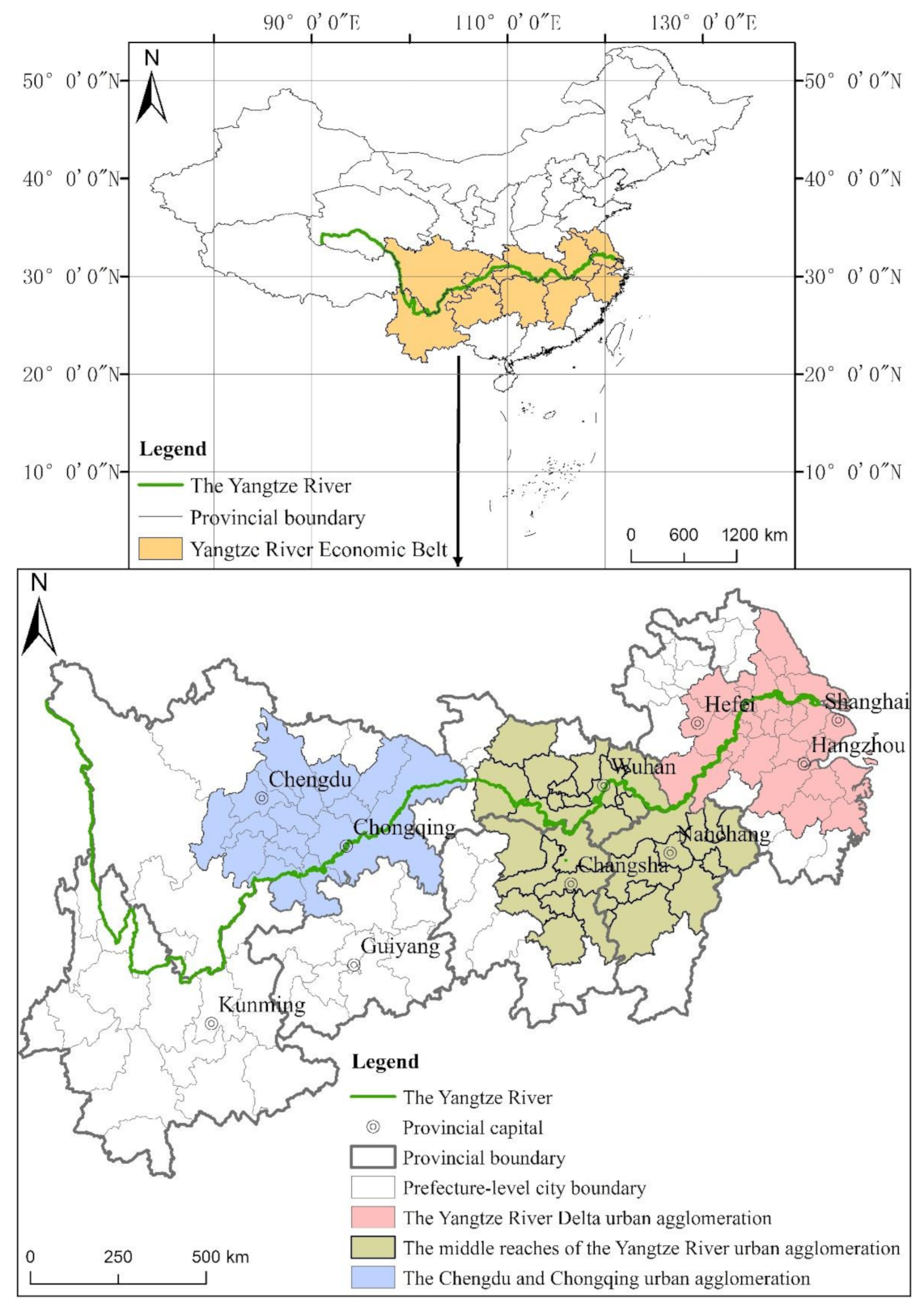
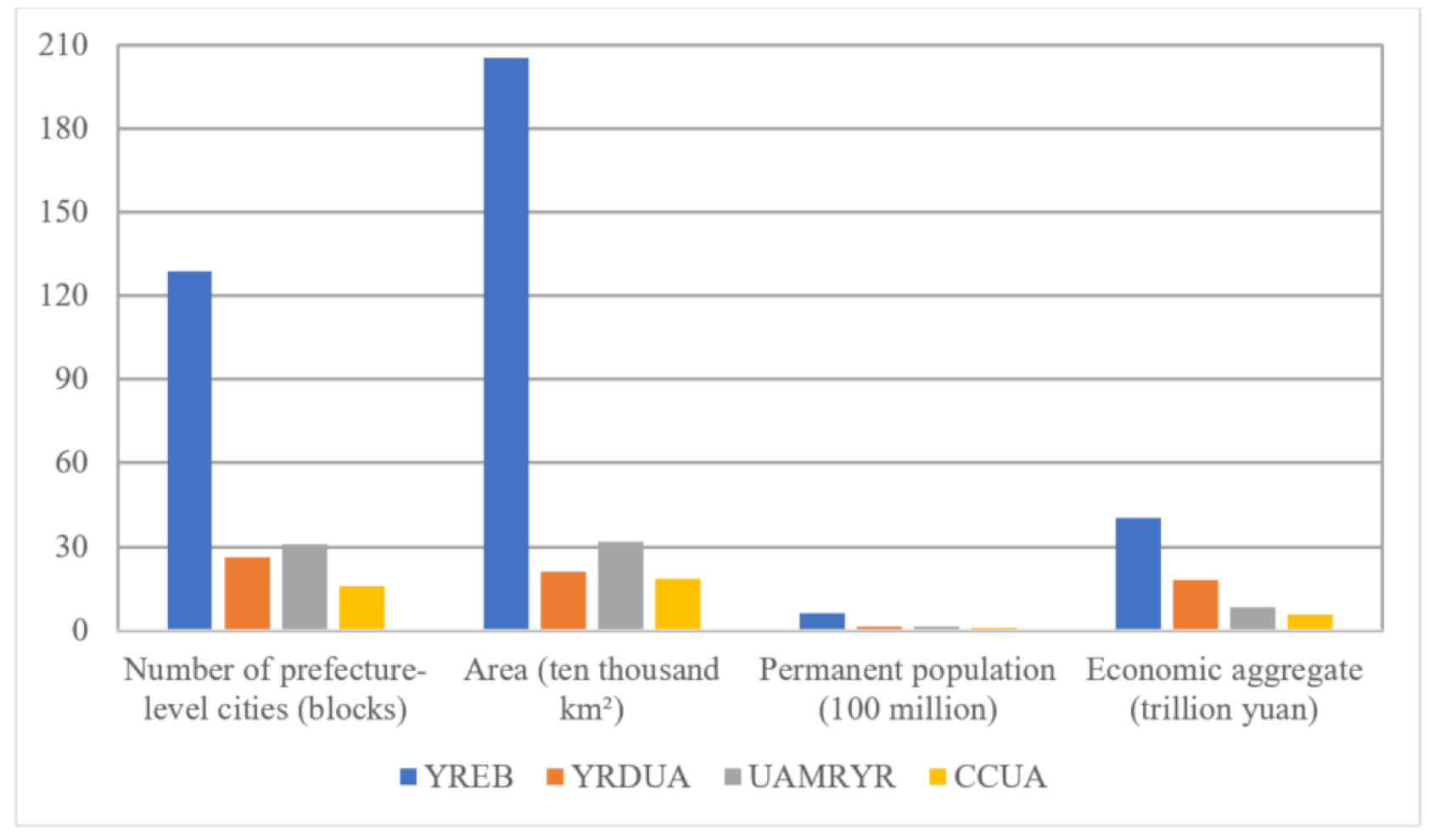
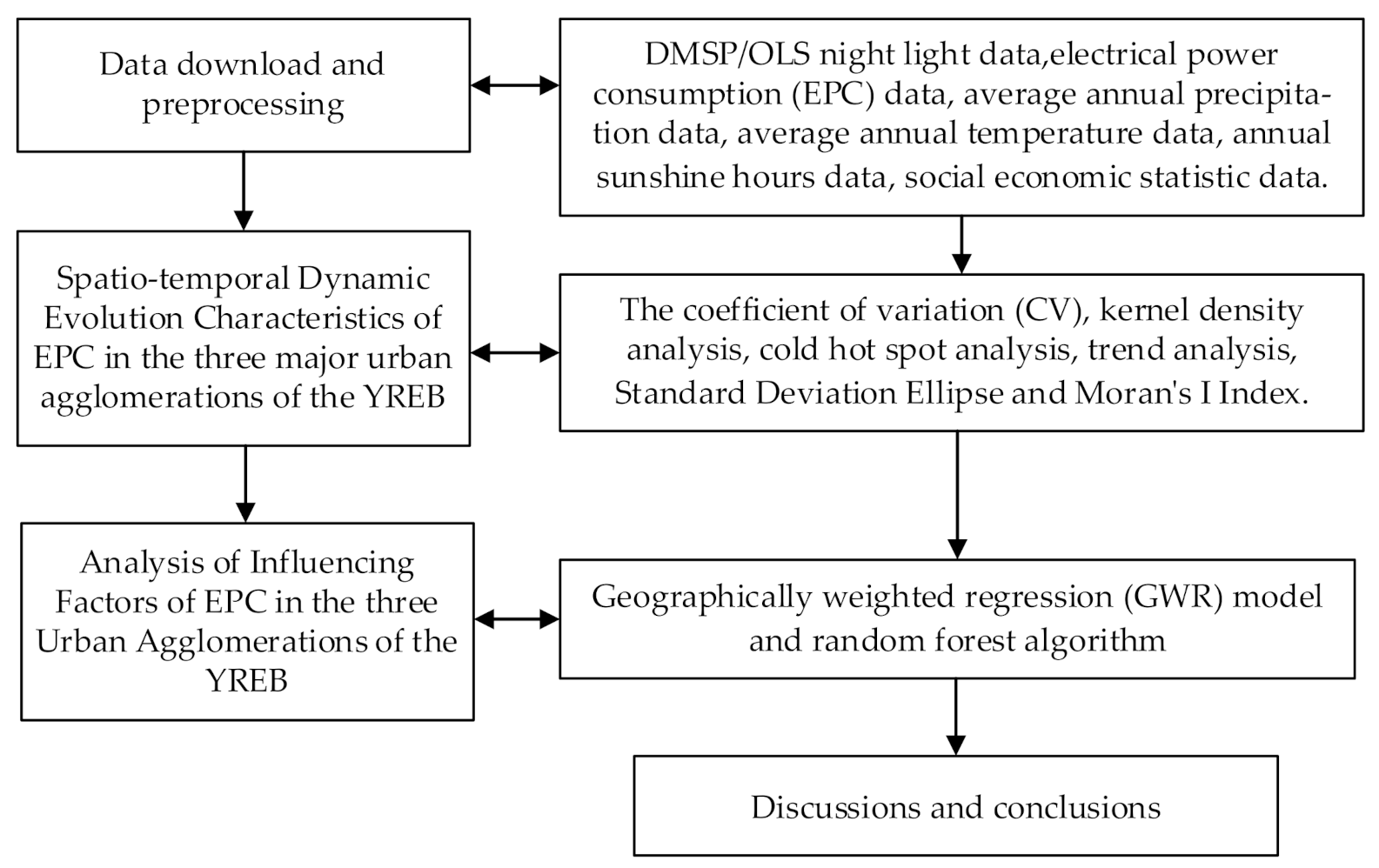
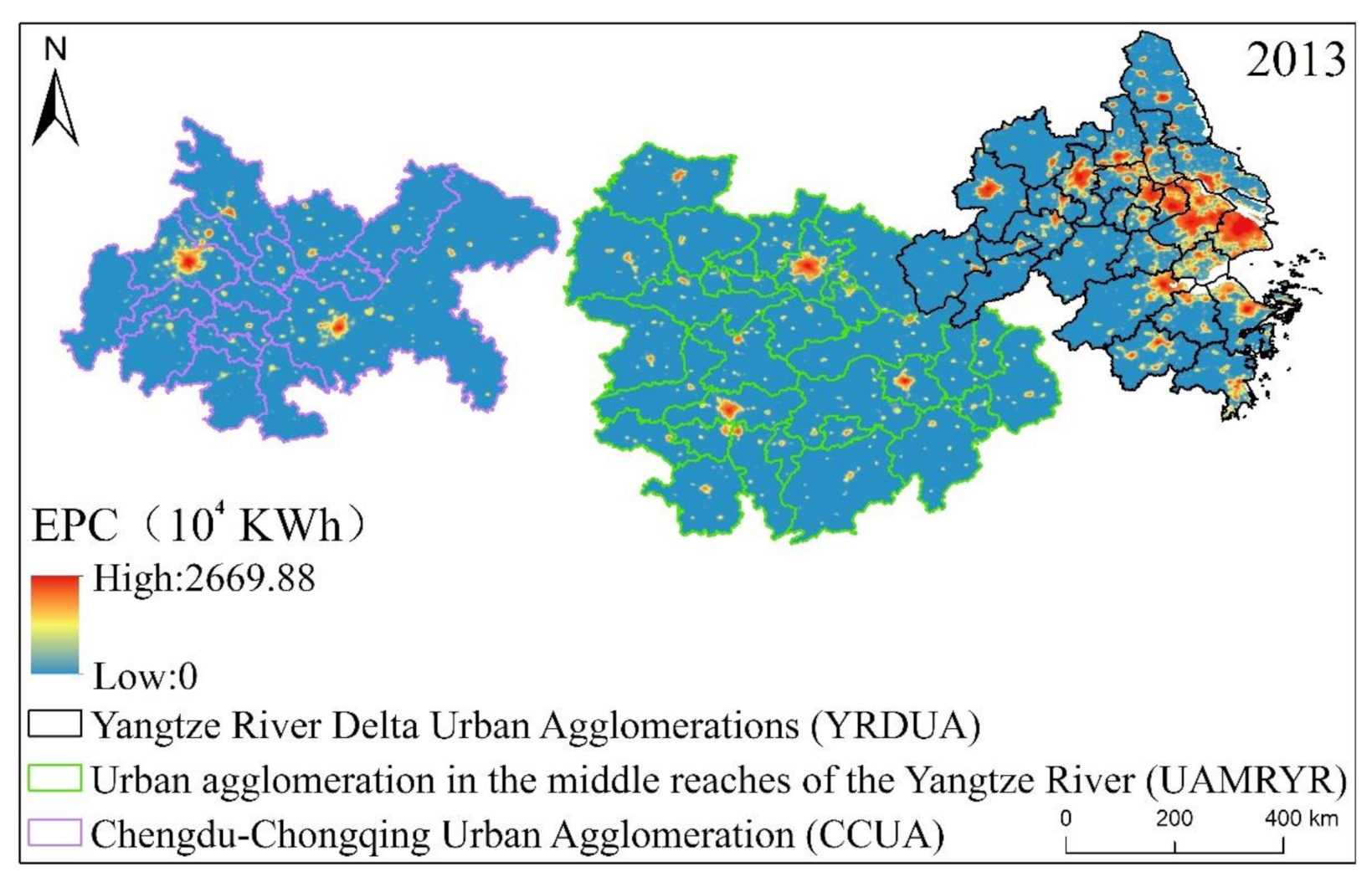

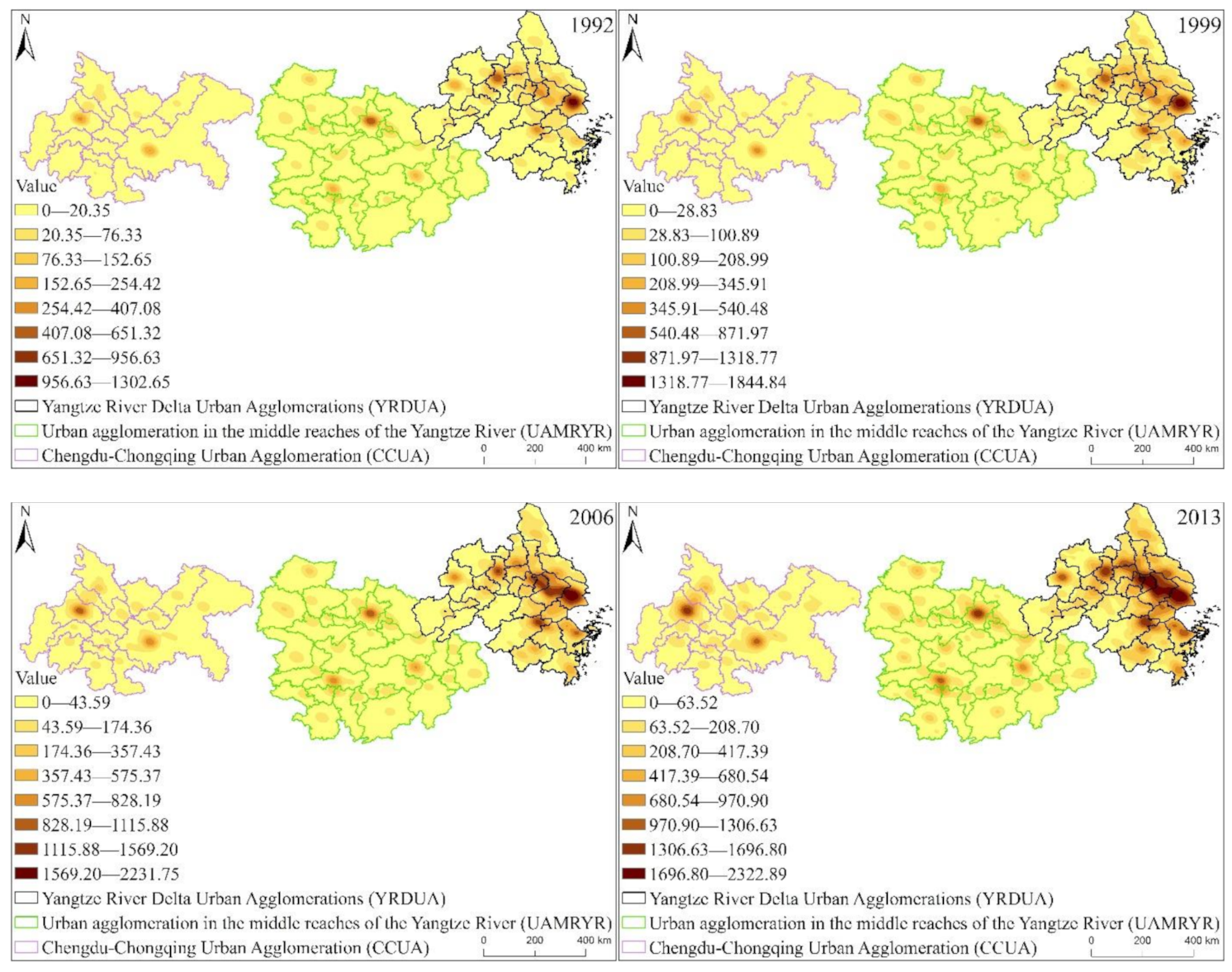


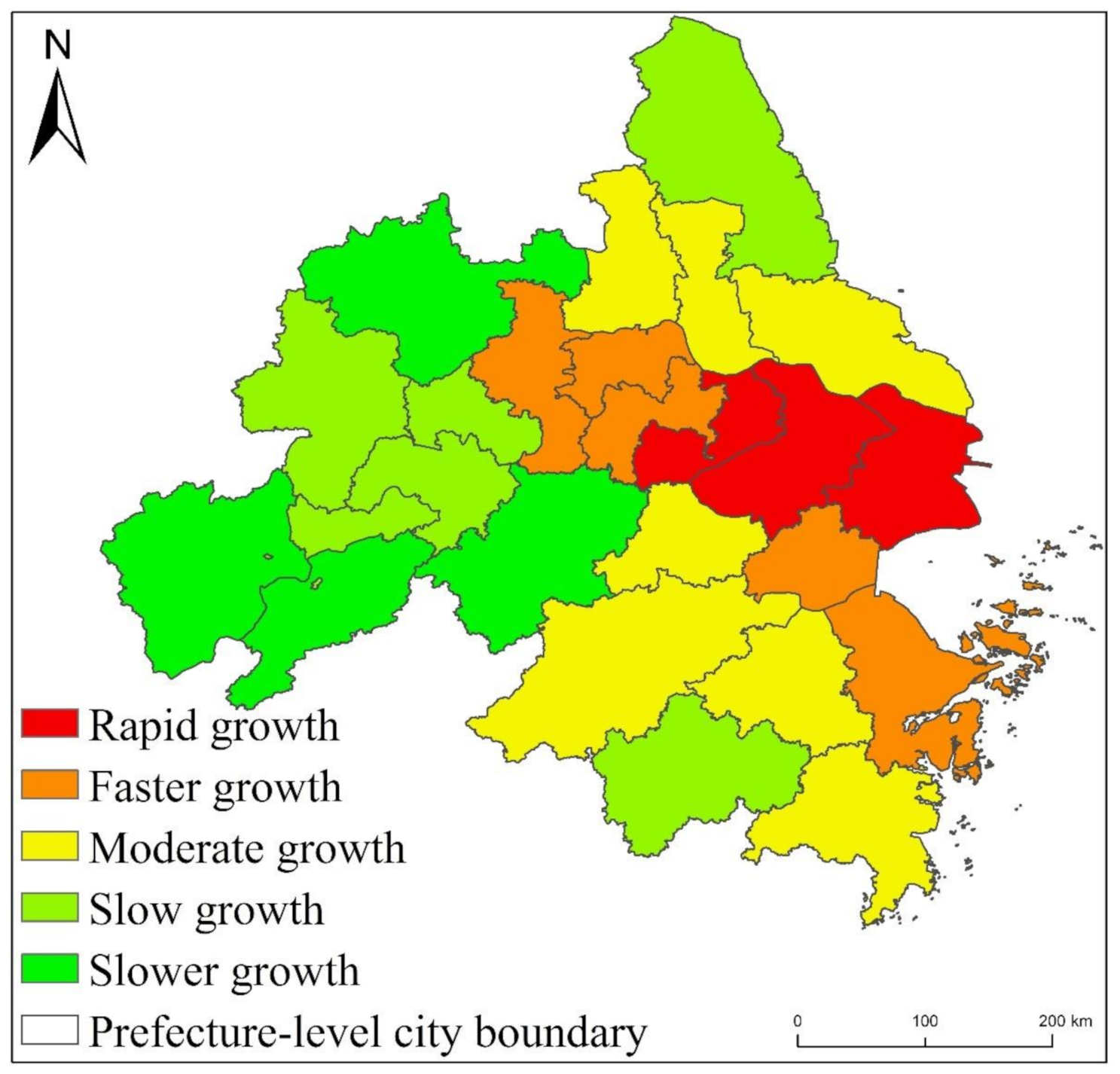
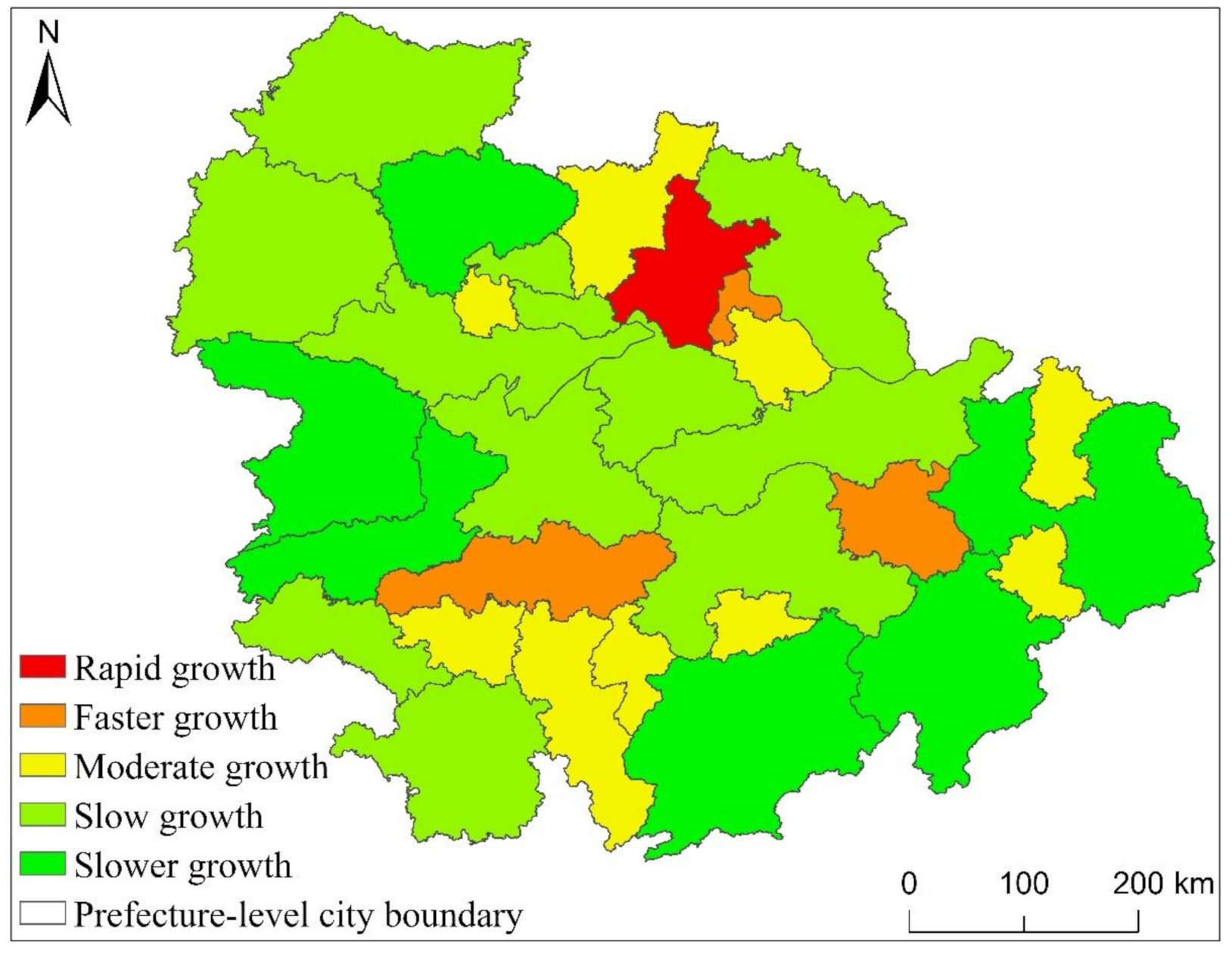
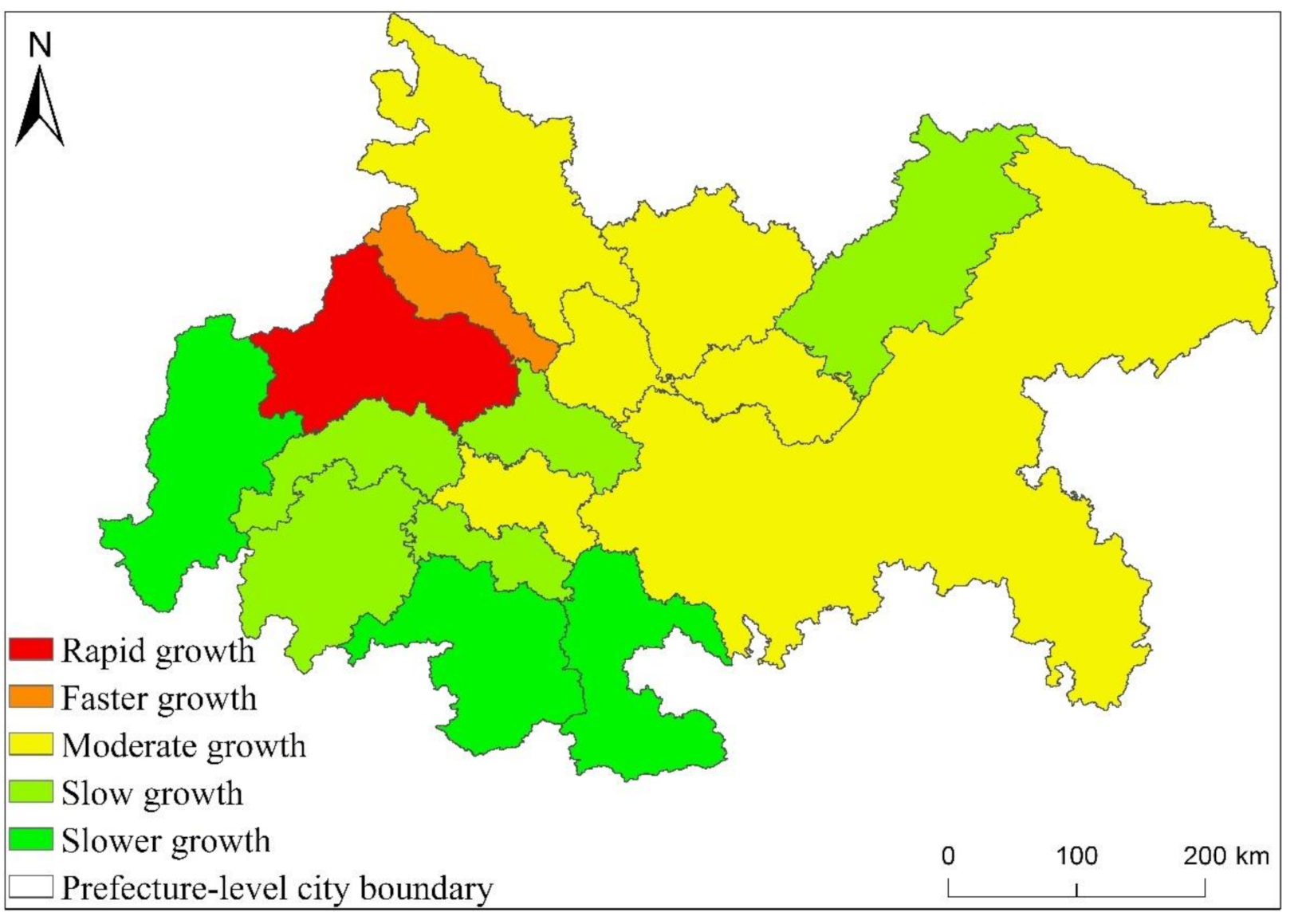

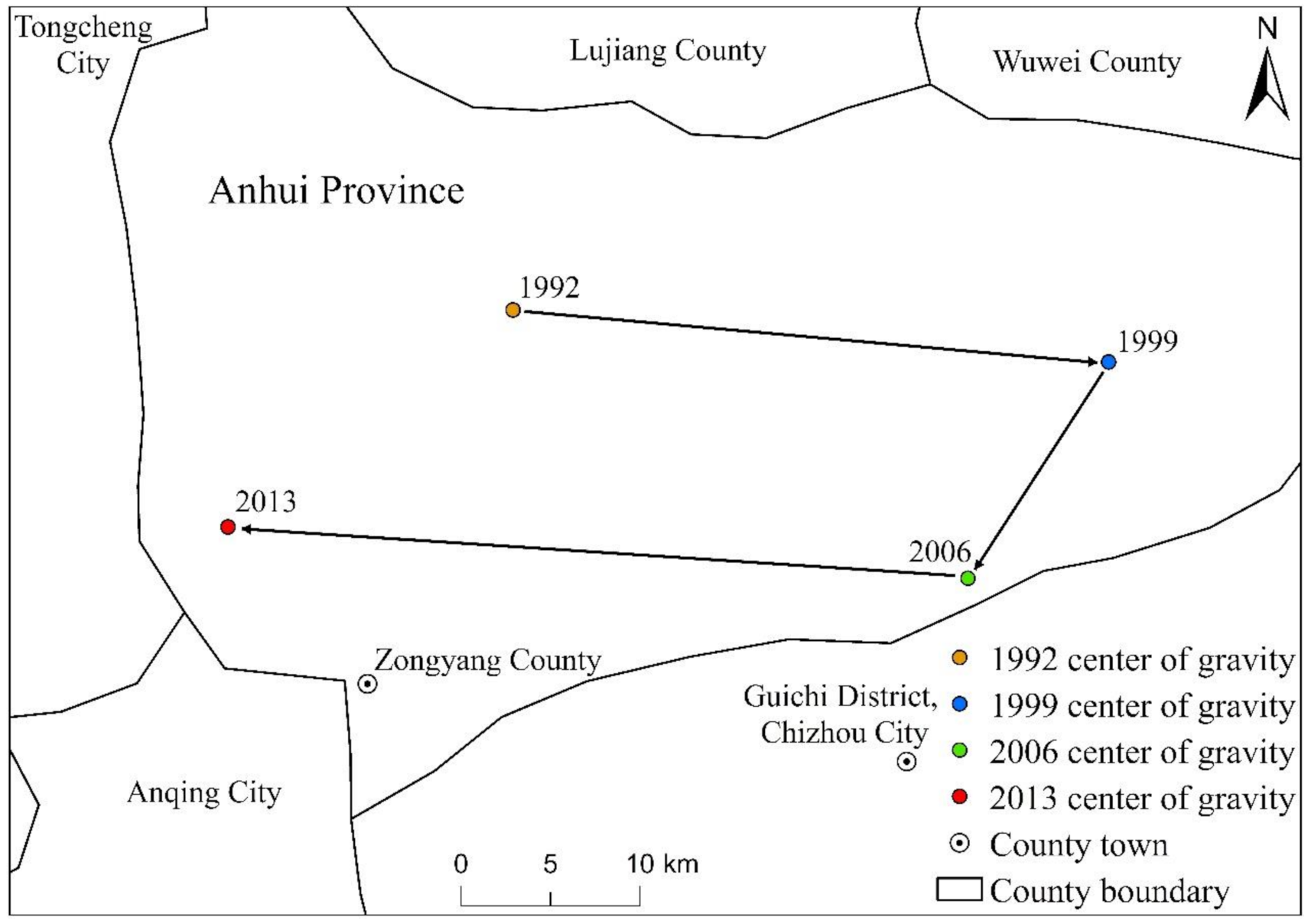
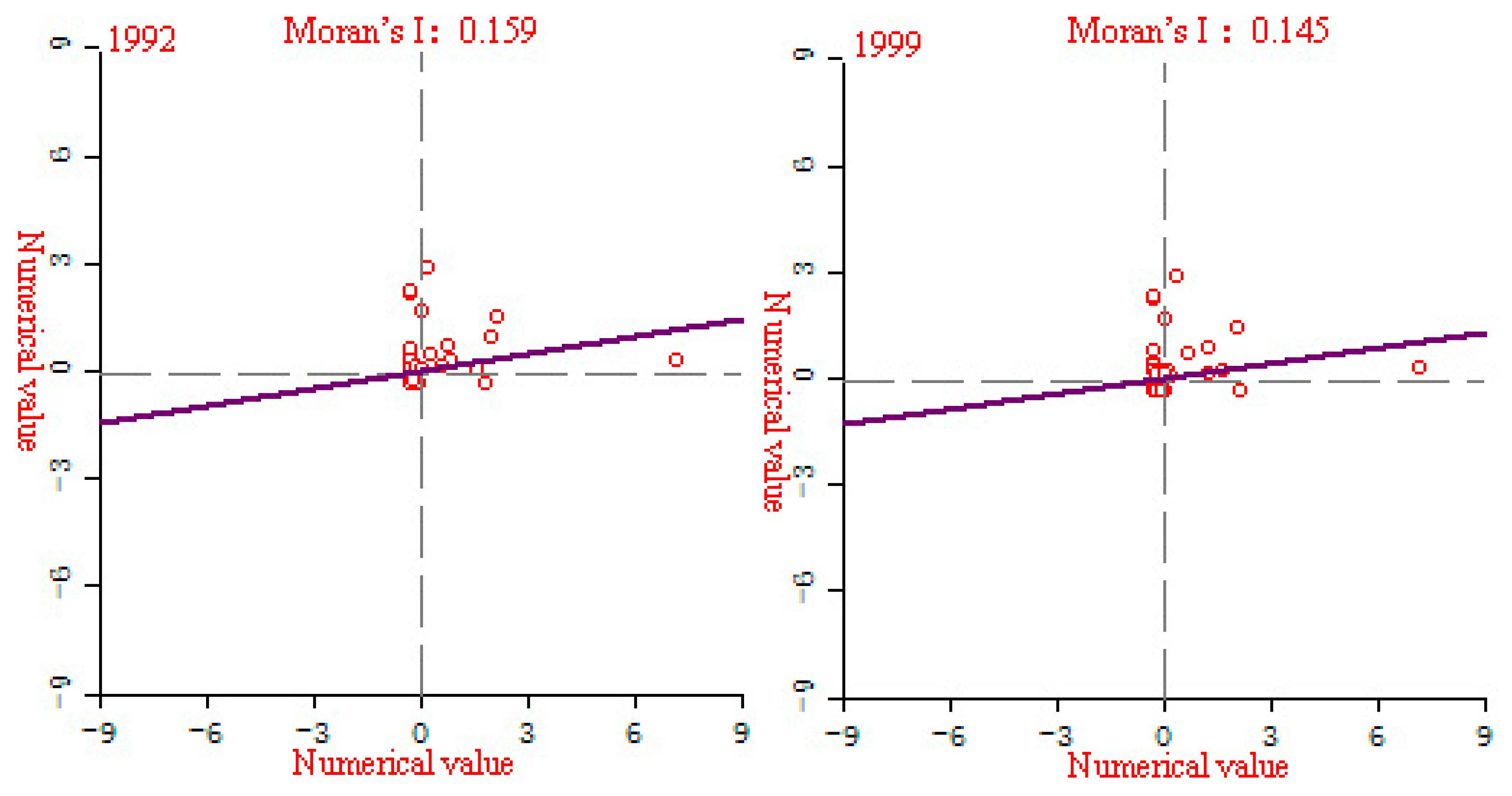
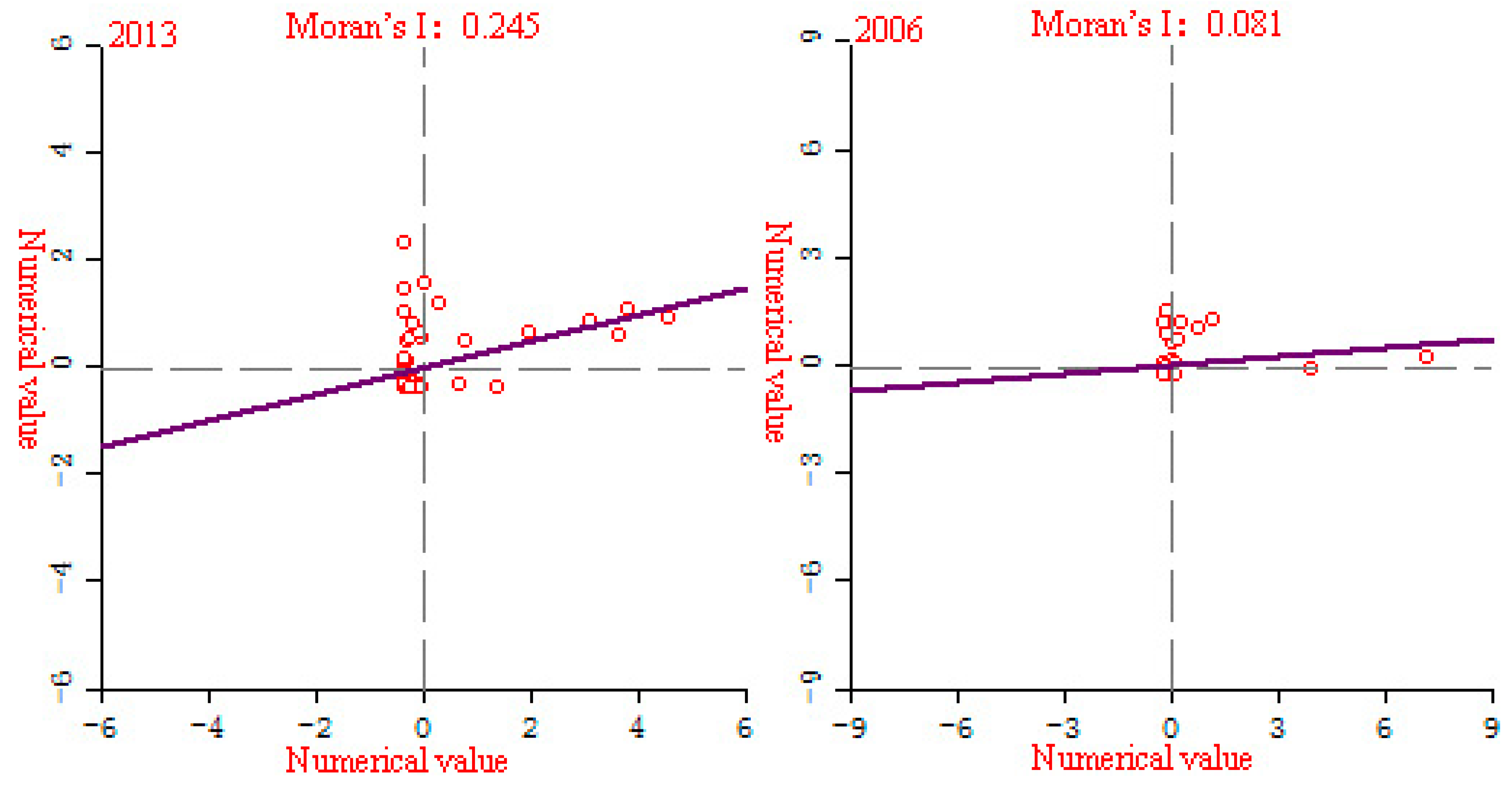
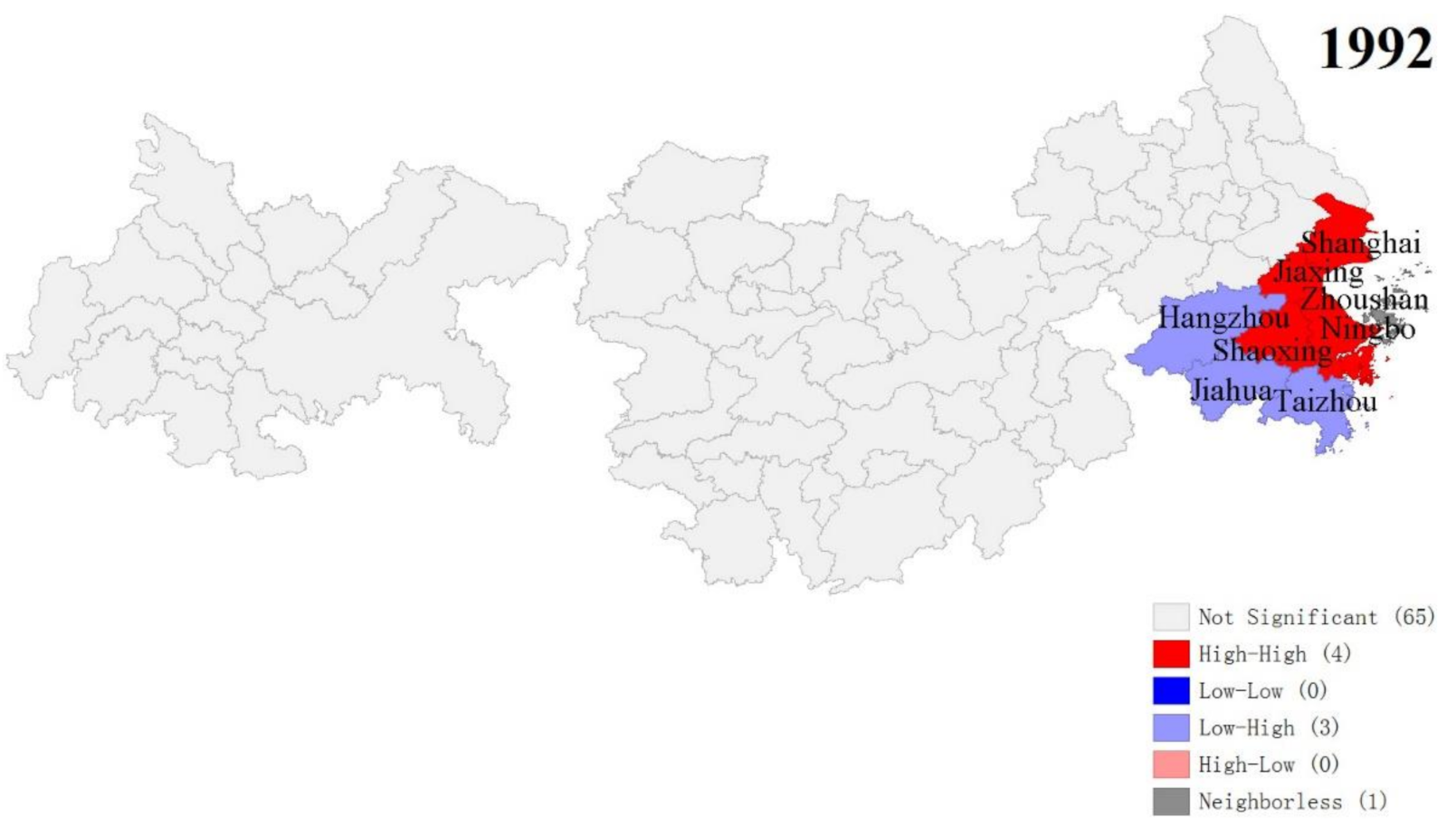

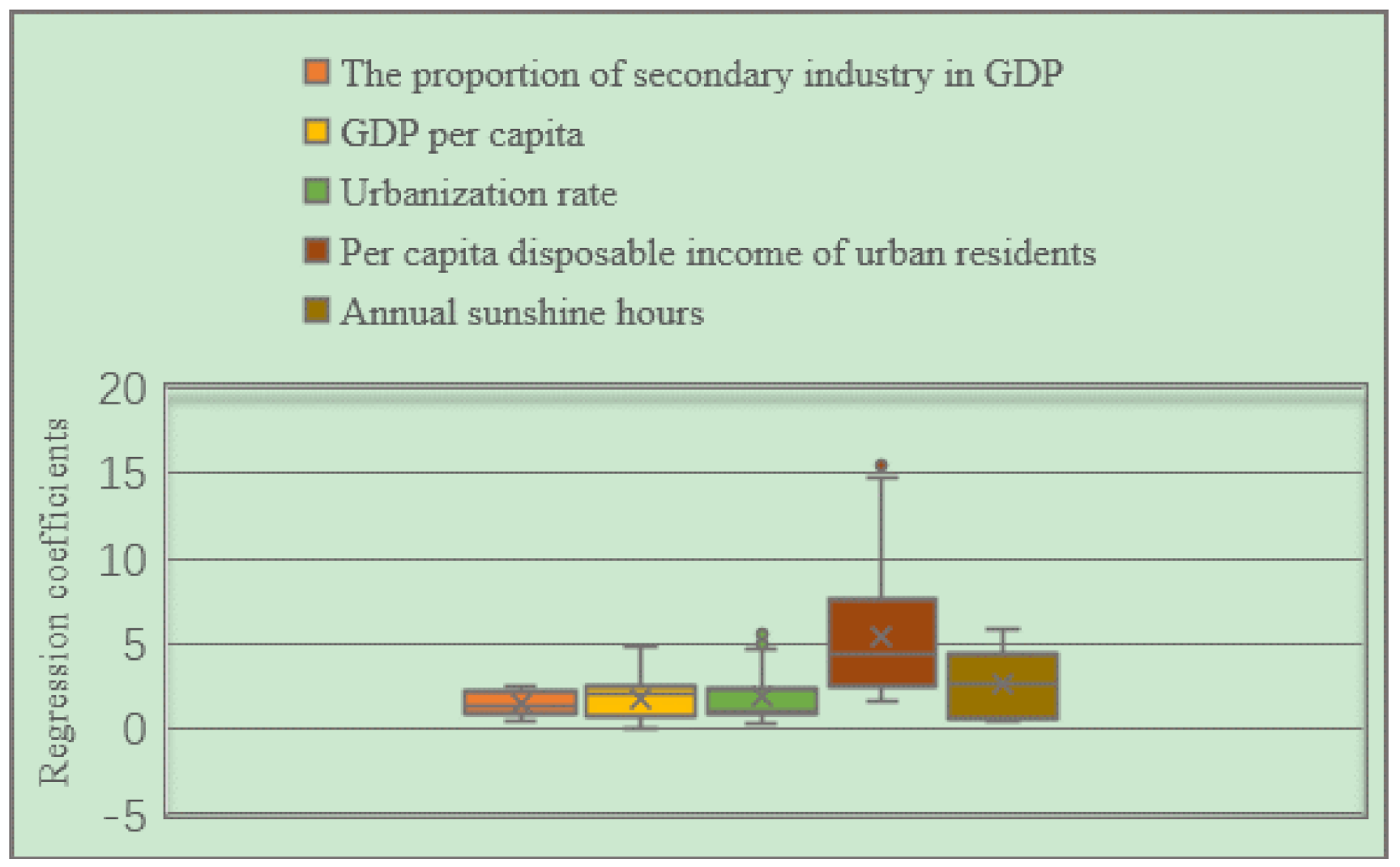

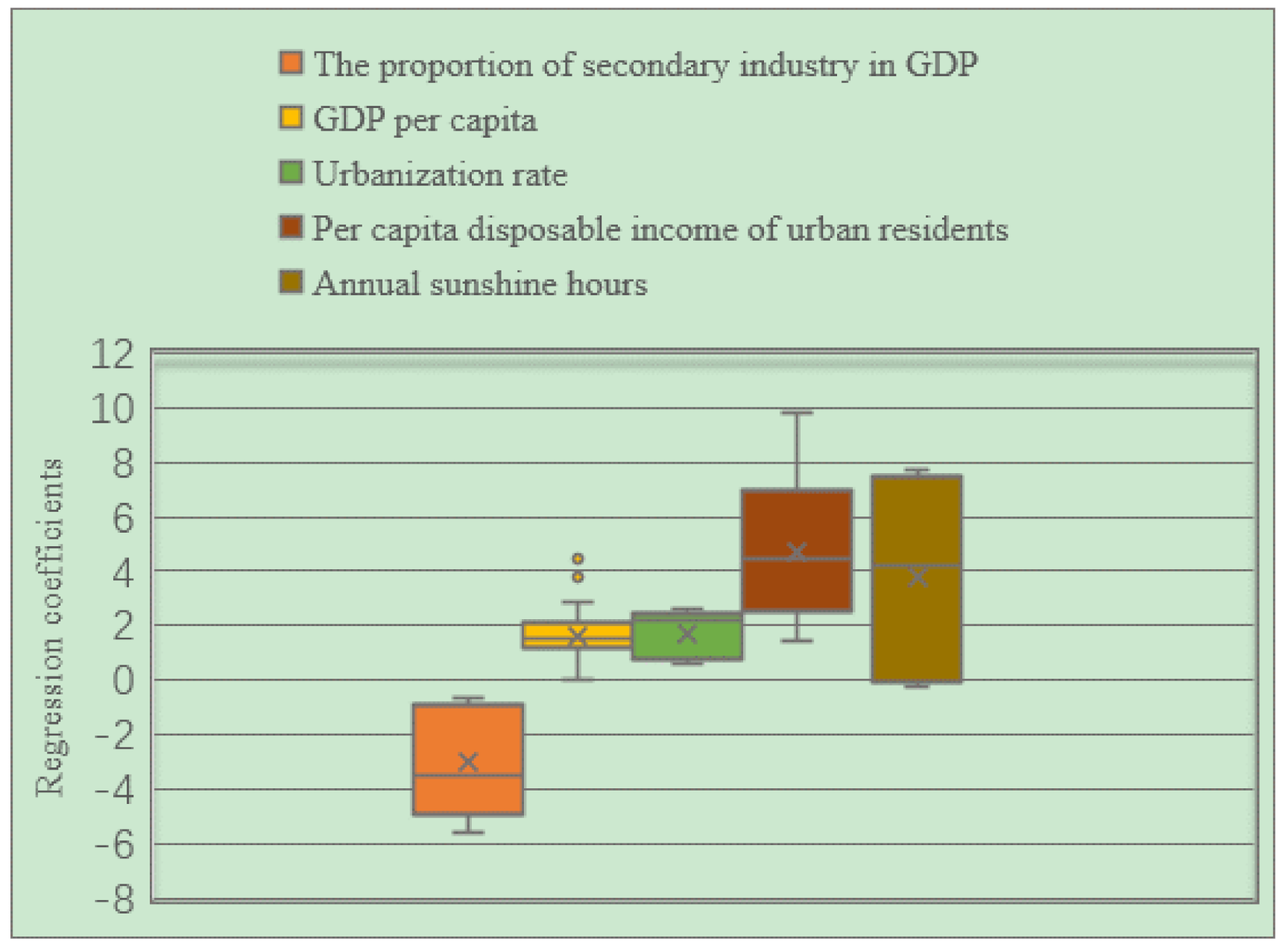
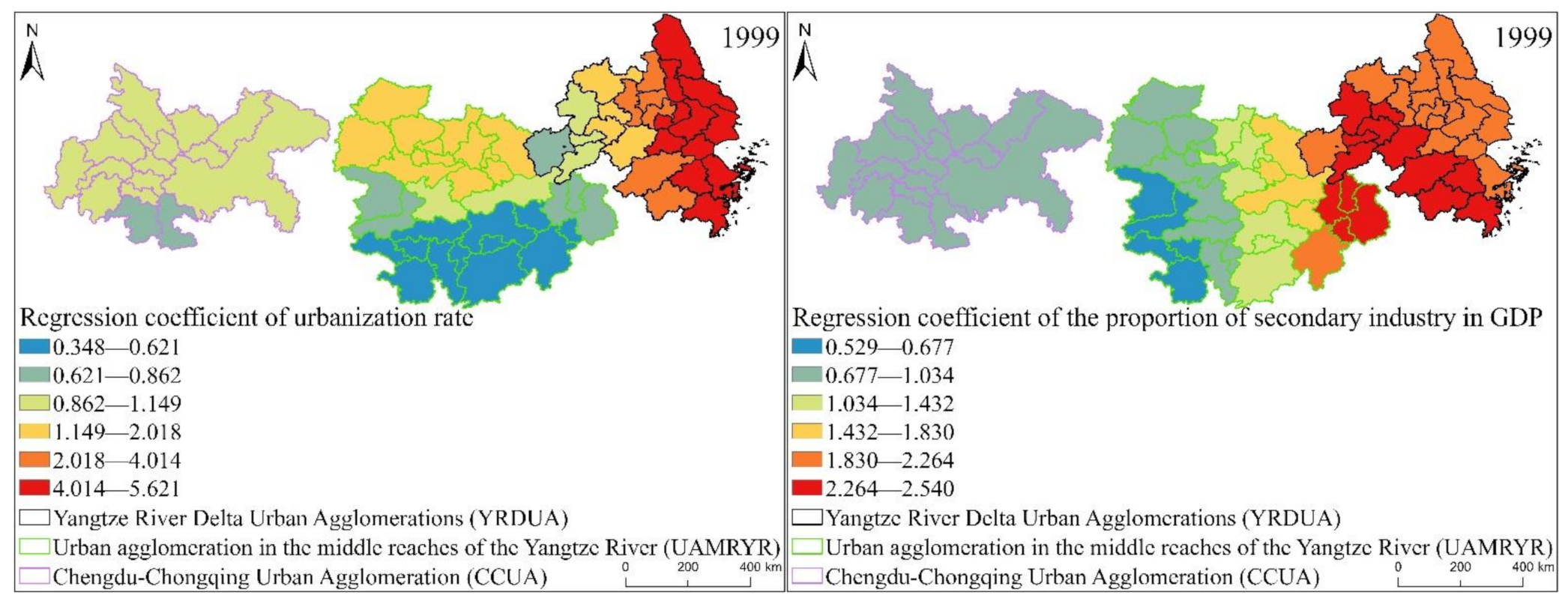
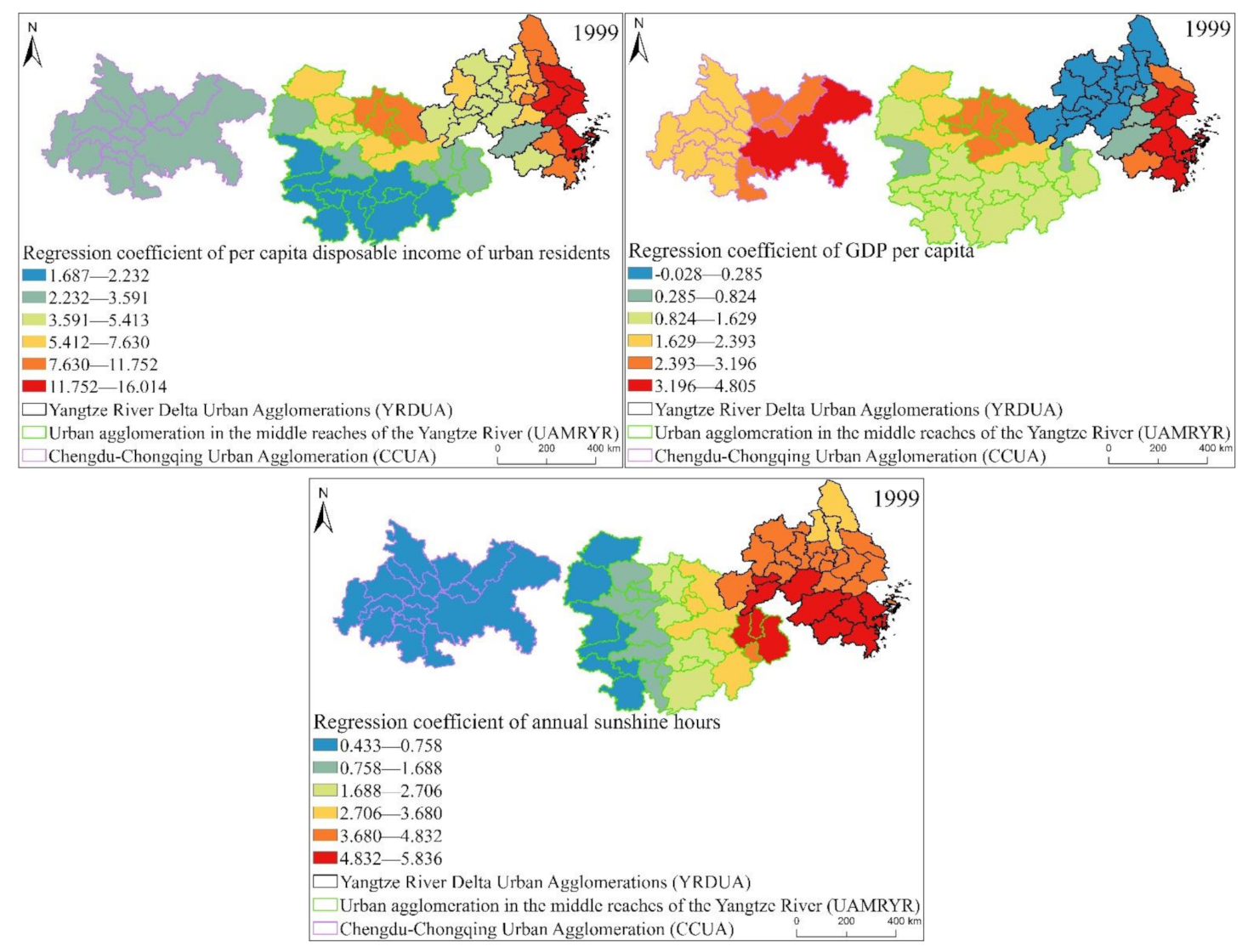

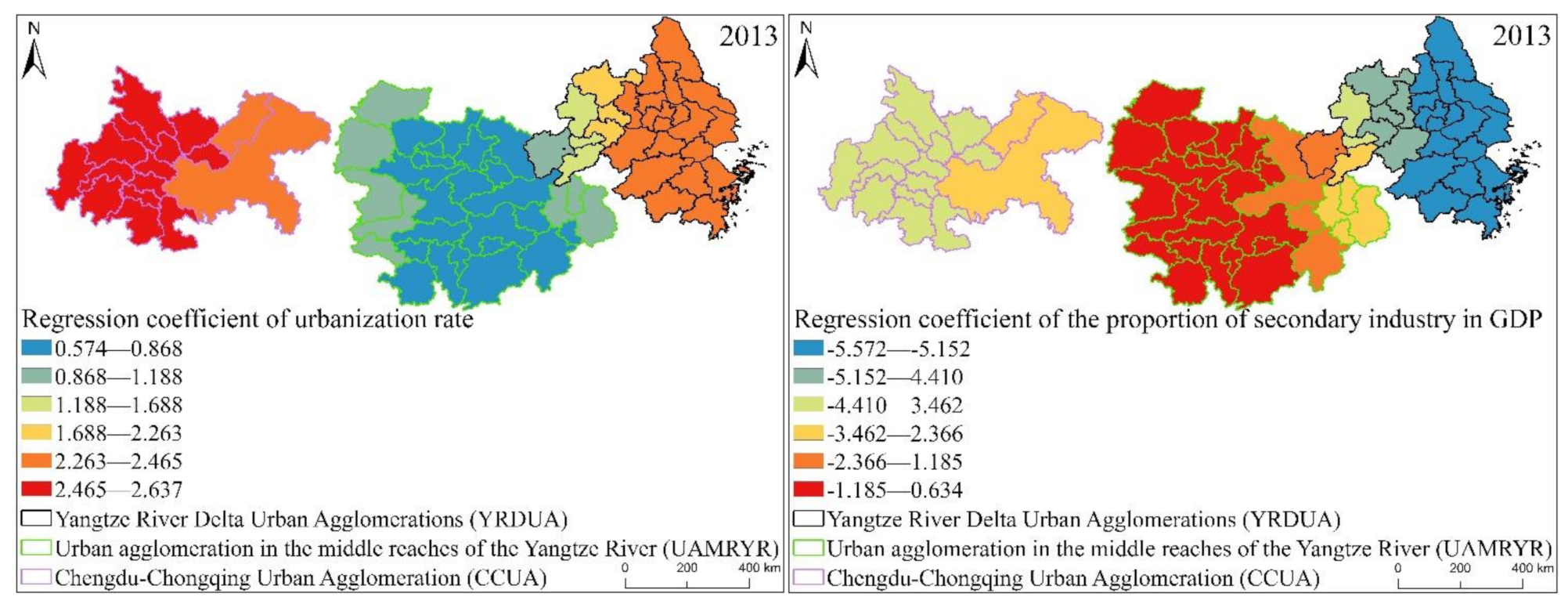

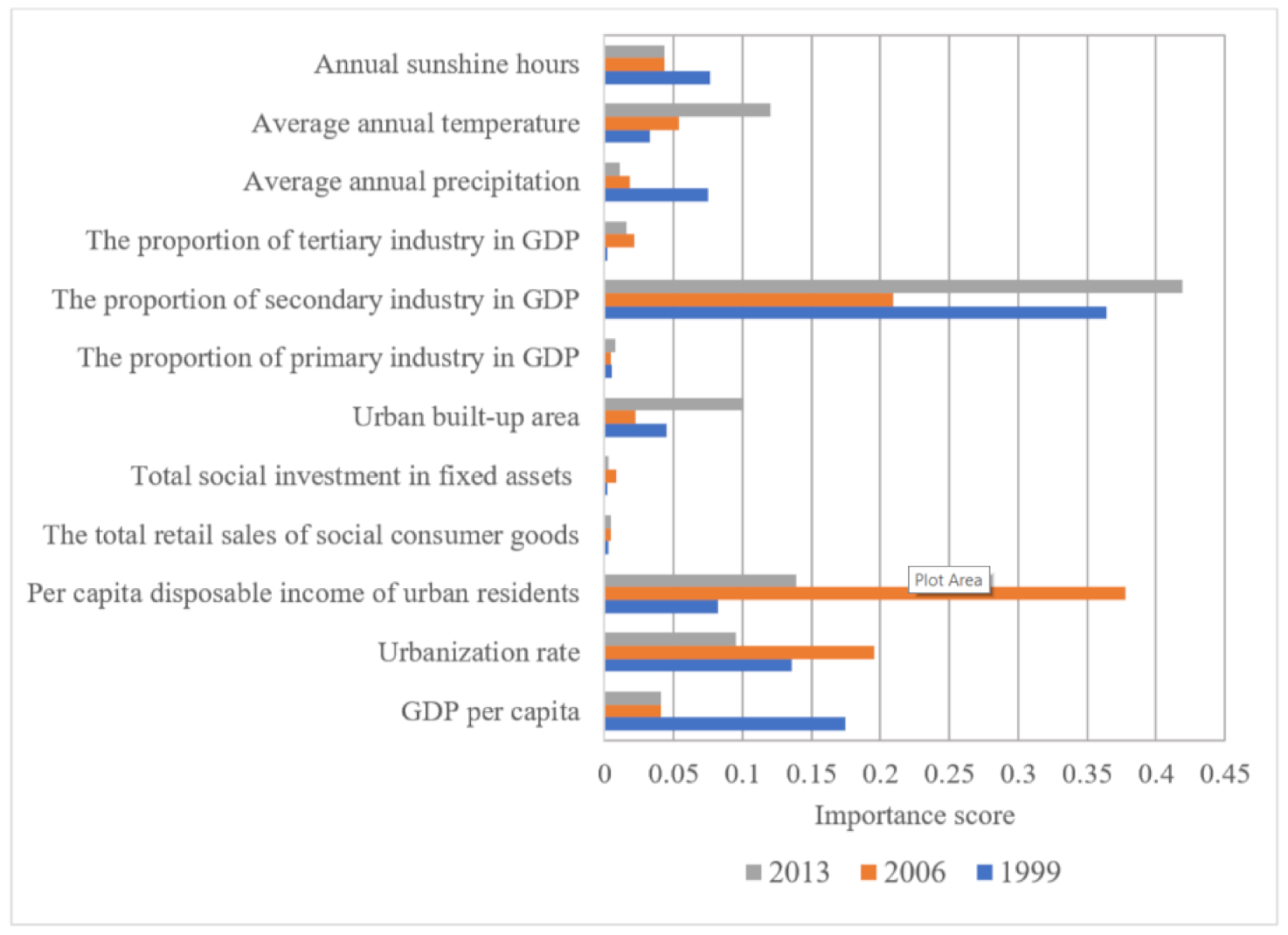
| Years | Center Coordinates | Length of Long Axis (km) | Length of SHORTAxis (km) | Area of the Ellipse (km2) |
|---|---|---|---|---|
| 1992 | (117.26 E, 30.93 N) | 657.87 | 173.89 | 359,284 |
| 1999 | (117.56 E, 30.91 N) | 650.93 | 183.04 | 374,203 |
| 2006 | (117.47 E, 30.80 N) | 680.70 | 191.21 | 408,788 |
| 2013 | (117.12 E, 30.84 N) | 696.90 | 199.43 | 436,514 |
| Year | Global Moran’s I Index | Z Value | p Value |
|---|---|---|---|
| 1992 | 0.58 | 6251.27 | <0.001 |
| 1999 | 0.65 | 7015.85 | <0.001 |
| 2006 | 0.74 | 7898.64 | <0.001 |
| 2013 | 0.77 | 8228.36 | <0.001 |
| Index | 1999 | 2006 | 2013 |
|---|---|---|---|
| R2 | 0.761 | 0.788 | 0.803 |
| Adjusted R2 | 0.732 | 0.751 | 0.771 |
| AICC | −385.135 | −408.463 | −442.457 |
| Sigma | 0.166 | 0.141 | 0.122 |
| Sort | 1999 | 2006 | 2013 | |||
|---|---|---|---|---|---|---|
| Influencing Factors | Importance Score | Influencing Factors | Importance Score | Influencing Factors | Importance Score | |
| 1 | The proportion of secondary industry in GDP | 0.364 | Per capita disposable income of urban residents | 0.378 | The proportion of secondary industry in GDP | 0.419 |
| 2 | GDP per capita | 0.175 | The proportion of secondary industry in GDP | 0.230 | Per capita disposable income of urban residents | 0.139 |
| 3 | Urbanization rate | 0.136 | Urbanization rate | 0.196 | Average annual temperature | 0.120 |
| 4 | Per capita disposable income of urban residents | 0.083 | Average annual temperature | 0.054 | Urban built-up area | 0.101 |
| 5 | Annual sunshine hours | 0.077 | Annual sunshine hours | 0.044 | Urbanization rate | 0.095 |
| 6 | Average annual precipitation | 0.075 | GDP per capita | 0.041 | Annual sunshine hours | 0.044 |
| 7 | Urban built-up area | 0.045 | Urban built-up area | 0.022 | GDP per capita | 0.041 |
| 8 | Average annual temperature | 0.033 | The proportion of tertiary industry in GDP | 0.022 | The proportion of tertiary industry in GDP | 0.016 |
| 9 | The proportion of primary industry in GDP | 0.006 | Average annual precipitation | 0.018 | Average annual precipitation | 0.011 |
| 10 | The total retail sales of social consumer goods | 0.003 | Total social investment in fixed assets | 0.008 | The proportion of primary industry in GDP | 0.008 |
| 11 | The proportion of tertiary industry in GDP | 0.002 | The total retail sales of social consumer goods | 0.004 | The total retail sales of social consumer goods | 0.005 |
| 12 | Total social investment in fixed assets | 0.002 | The proportion of primary industry in GDP | 0.004 | Total social investment in fixed assets | 0.003 |
Publisher’s Note: MDPI stays neutral with regard to jurisdictional claims in published maps and institutional affiliations. |
© 2021 by the authors. Licensee MDPI, Basel, Switzerland. This article is an open access article distributed under the terms and conditions of the Creative Commons Attribution (CC BY) license (http://creativecommons.org/licenses/by/4.0/).
Share and Cite
Zhong, Y.; Lin, A.; Xiao, C.; Zhou, Z. Research on the Spatio-Temporal Dynamic Evolution Characteristics and Influencing Factors of Electrical Power Consumption in Three Urban Agglomerations of Yangtze River Economic Belt, China Based on DMSP/OLS Night Light Data. Remote Sens. 2021, 13, 1150. https://doi.org/10.3390/rs13061150
Zhong Y, Lin A, Xiao C, Zhou Z. Research on the Spatio-Temporal Dynamic Evolution Characteristics and Influencing Factors of Electrical Power Consumption in Three Urban Agglomerations of Yangtze River Economic Belt, China Based on DMSP/OLS Night Light Data. Remote Sensing. 2021; 13(6):1150. https://doi.org/10.3390/rs13061150
Chicago/Turabian StyleZhong, Yang, Aiwen Lin, Chiwei Xiao, and Zhigao Zhou. 2021. "Research on the Spatio-Temporal Dynamic Evolution Characteristics and Influencing Factors of Electrical Power Consumption in Three Urban Agglomerations of Yangtze River Economic Belt, China Based on DMSP/OLS Night Light Data" Remote Sensing 13, no. 6: 1150. https://doi.org/10.3390/rs13061150
APA StyleZhong, Y., Lin, A., Xiao, C., & Zhou, Z. (2021). Research on the Spatio-Temporal Dynamic Evolution Characteristics and Influencing Factors of Electrical Power Consumption in Three Urban Agglomerations of Yangtze River Economic Belt, China Based on DMSP/OLS Night Light Data. Remote Sensing, 13(6), 1150. https://doi.org/10.3390/rs13061150





